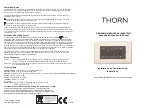
Overview
5
3.2 Recommendations for Best Performance
To achieve the best performance:
•
Connect only good quality connection cables, thus avoiding interference,
deterioration in signal quality due to poor matching, and elevated noise
levels (often associated with low quality cables)
•
Avoid interference from neighboring electrical appliances and position
your
VS-311H
away from moisture, excessive sunlight and dust
3.3 Terminology Used in this User Manual
Table 1
defines some terms that are used in this user manual.
Table 1: Terminology Used in this User Manual
Term
Definition
802.3
The standard specification for ETHERNET that is maintained by the Ins itute of Electrical
and Electronics Engineers (IEEE).
Dynamic Host
Configuration
Protocol (DHCP)
Allows he network administrator to distribute IP addresses from a central point and
automatically send a new IP address when an Ethernet point is plugged into a different
network location.
Gateway
A network position serving as an entry to ano her network. On the Internet, a node or
stopping point can be either a gateway node or a host (end-point) node.
IP Address
A 32-binary digit number that identifies each sender or receiver (within a network via a
par icular server or workstation) of data (HTML pages or e-mails) hat is sent in packets
across the Internet. Every device connected to an IP network must have a unique IP
address. This address is used to reference the specific unit.
Local Area Network
(LAN)
Computers sharing a common communications line or wireless link, which often share a
server within a defined geographic area.
Media Access
Control (MAC)
Address
A computer's unique hardware number (or address) in a LAN or other network. On an
E hernet LAN, the (MAC) address is identical to he Ethernet address.
Transmission
Control
Protocol/Internet
Protocol (TCP/IP)
The basic communication language or protocol of the Internet that breaks the message
into appropriately sized packets for the network, and can be used as a communications
protocol in an intranet or an extranet.







































